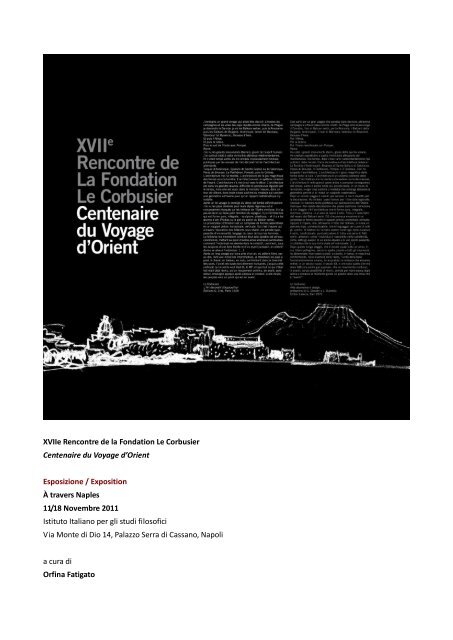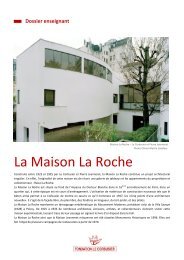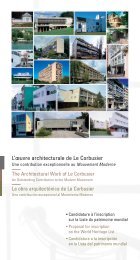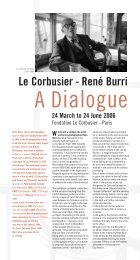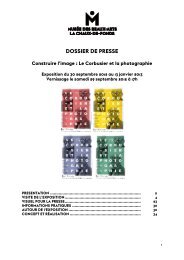XVIIe Rencontre de la Fondation Le Corbusier
XVIIe Rencontre de la Fondation Le Corbusier
XVIIe Rencontre de la Fondation Le Corbusier
Create successful ePaper yourself
Turn your PDF publications into a flip-book with our unique Google optimized e-Paper software.
<strong>XVIIe</strong> <strong>Rencontre</strong> <strong>de</strong> <strong>la</strong> <strong>Fondation</strong> <strong>Le</strong> <strong>Corbusier</strong><br />
Centenaire du Voyage d’Orient<br />
Esposizione / Exposition<br />
À travers Naples<br />
11/18 Novembre 2011<br />
Istituto Italiano per gli studi filosofici<br />
Via Monte di Dio 14, Pa<strong>la</strong>zzo Serra di Cassano, Napoli<br />
a cura di<br />
Orfina Fatigato
allestimento<br />
Orfina Fatigato<br />
Maria Luna Nobile<br />
grafica<br />
Franco Lancio<br />
Nel maggio 1911 il giovane Charles-Édouard Jeanneret (<strong>Le</strong> <strong>Corbusier</strong>) parte per l’Oriente: visita Berlino,<br />
Dresda, Praga e Vienna, <strong>la</strong> Cecoslovacchia, l’Ungheria, <strong>la</strong> Serbia, <strong>la</strong> Romania, <strong>la</strong> Bulgaria, costeggia il<br />
Danubio e i Balcani, raggiunge Istanbul, poi Atene e infine rientra in Italia da sud passando per Napoli e<br />
Pompei. Un sorta di Grand Tour all’incontrario, durante il quale esegue oltre 300 disegni, riempie sei carnet<br />
con schizzi e commenti, scatta più di 400 fotografie, scrive lettere, annota avvenimenti ed invia<br />
rego<strong>la</strong>rmente articoli redatti durante il viaggio al Feuille d’avis, giornale locale di La Chaux-<strong>de</strong>-Fonds.<br />
A partire dalle sue annotazioni e dagli articoli pubblicati, <strong>Le</strong> <strong>Corbusier</strong> redige lo scritto Voyage en Orient che<br />
avrebbe voluto pubblicare già tra il 1912 ed 1914 al rientro dal suo lungo viaggio. Nel 1965, un mese prima<br />
di morire, <strong>Le</strong> <strong>Corbusier</strong> apporta le ultime correzioni al manoscritto <strong>de</strong>l Voyage d’Orient che verrà finalmente<br />
pubblicato solo nel 1966, dopo <strong>la</strong> sua morte. L’ultimo capitolo <strong>de</strong>l libro è intito<strong>la</strong>to En Occi<strong>de</strong>nt e come <strong>Le</strong><br />
<strong>Corbusier</strong> annota, fu finito di scrivere il 10 ottobre 1911 a Napoli.<br />
In realtà dopo il 10 ottobre <strong>la</strong>sciando Napoli <strong>Le</strong> <strong>Corbusier</strong> prosegue il suo viaggio in Italia, a Pompei, Roma,<br />
Pisa, Firenze, ma ritiene il suo Voyage d’Orient ormai concluso. Napoli è città di frontiera non più Oriente e<br />
non ancora pienamente Occi<strong>de</strong>nte.<br />
A’ travers Naples, a partire dai noti studi sul Voyage d’Orient <strong>de</strong>l Prof. Gresleri, racconta <strong>de</strong>l breve passaggio<br />
a Napoli di <strong>Le</strong> <strong>Corbusier</strong> ed ipotizza tempi e sequenze <strong>de</strong>i possibili attraversamenti <strong>de</strong>l<strong>la</strong> città nei giorni <strong>de</strong>l<br />
6,7,8,10 ottobre 1911. In A’ travers Naples si ipotizza che il mercoledì 4 Ottobre Ch.-E. Jeanneret sia partito<br />
da Patrasso e dopo un giorno e mezzo di viaggio sia giunto a Brindisi <strong>la</strong> mattina <strong>de</strong>l 6 ottobre alle ore 3.45,<br />
per poi proseguire con il treno <strong>de</strong>lle ore 7.15 verso Napoli dove dovrebbe essere arrivato dunque intorno<br />
alle ore 18.30 nel giorno <strong>de</strong>l suo ventiquattresimo compleanno.<br />
Il sabato 7 ottobre e <strong>la</strong> domenica 8 ottobre il giovane Ch.-E. Jeanneret visita <strong>la</strong> città, seguendo piuttosto<br />
fe<strong>de</strong>lmente le indicazioni <strong>de</strong>l<strong>la</strong> sua guida Bae<strong>de</strong>ker - L’Italie <strong>de</strong>s Alpes à Naples. Nel tardo pomeriggio di<br />
domenica 8 ottobre parte per Pompei dove resta fino al lunedì 10, giorno in cui <strong>de</strong>ci<strong>de</strong> di ritornare a Napoli<br />
per visitare nuovamente il Museo Nazionale, ove trascorre l’intera giornata <strong>de</strong>l 10 per poi ripartire<br />
nuovamente per Pompei. Resterà a Pompei tre giorni fino al sabato 14 ottobre, giorno in cui dopo aver<br />
probabilmente visitato Paestum riparte per Roma con il treno diretto <strong>de</strong>lle 18.50.<br />
A’ travers Naples suggerisce uno <strong>de</strong>i possibili racconti <strong>de</strong>lle giornate napoletane di <strong>Le</strong> <strong>Corbusier</strong>,<br />
ricostruendo un mosaico, inevitabilmente incompleto, composto da diversi frammenti – le brevi<br />
annotazioni, gli schizzi che si succedono nel suo quarto Carnet <strong>de</strong>l Voyage d’Orient, le tante fotografie<br />
scattate, le lettere inviate, – tutti preziosamente custoditi nell’ archivio <strong>de</strong>lle <strong>Fondation</strong> <strong>Le</strong> <strong>Corbusier</strong>, Paris.
CREDITS<br />
La trascrizione in francese <strong>de</strong>i testi contenuti nei Carnets <strong>de</strong>l Voyage d’Orient sono tratti da G. Gresleri (a<br />
cura di), Voyage d’Orient Carnets, Electa <strong>Fondation</strong> L.C., Mi<strong>la</strong>no 2000.<br />
I testi in italiano <strong>de</strong>lle lettere di <strong>Le</strong> <strong>Corbusier</strong> indirizzate al<strong>la</strong> sua famiglia e a Ritter sono tratti da G. Gresleri<br />
(a cura di), Viaggio in Oriente, Marsilio <strong>Fondation</strong> <strong>Le</strong> <strong>Corbusier</strong>, Venezia 1995<br />
I testi in francese <strong>de</strong>lle lettere di <strong>Le</strong> <strong>Corbusier</strong> indirizzate al<strong>la</strong> sua famiglia sono tratti da R. Baudouï et A.<br />
Dercelles (a cura di), <strong>Le</strong> <strong>Corbusier</strong>. Correspondance <strong>Le</strong>ttres à <strong>la</strong> famille1900-1925, Infolio, Paris 2011.<br />
<strong>Le</strong> riproduzioni <strong>de</strong>lle fotografie <strong>de</strong>gli antichi allestimenti <strong>de</strong>l Museo Nazionale di Napoli (MANN) sono tratte<br />
in parte da A. Mi<strong>la</strong>nese, Album museo, Electa, Napoli 2009 e messe a disposizione dal<strong>la</strong> Soprinten<strong>de</strong>nza<br />
Speciale per il Beni Archeologici di Napoli e Pompei.<br />
<strong>Le</strong> riproduzioni <strong>de</strong>lle fotografie indicate con <strong>la</strong> sig<strong>la</strong> SSBANP sono tratte dall’archivio fotografico <strong>de</strong>l Museo<br />
Archeologico di Napoli e gentilmente messe a disposizione dal<strong>la</strong> Soprinten<strong>de</strong>nza Speciale per il Beni<br />
Archeologici di Napoli e Pompei.<br />
Si ringraziano:<br />
Roberta Amirante, Responsabile scientifico <strong>de</strong>l <strong>XVIIe</strong> <strong>Rencontre</strong> Naples, C<strong>la</strong>u<strong>de</strong> Prelorenzo Segretario <strong>de</strong>l<strong>la</strong><br />
<strong>Fondation</strong> <strong>Le</strong> <strong>Corbusier</strong>, Michel Richard Direttore <strong>de</strong>l<strong>la</strong> <strong>Fondation</strong> per aver sostenuto ed incoraggiato <strong>la</strong><br />
ricerca ren<strong>de</strong>ndone possibile lo sviluppo.<br />
Arnaud Dercelles e Isabelle Godineau, Responsabile <strong>de</strong>l<strong>la</strong> Biblioteca e Responsabile <strong>de</strong>ll’Archivio <strong>de</strong>l<strong>la</strong><br />
<strong>Fondation</strong> <strong>Le</strong> <strong>Corbusier</strong>, per <strong>la</strong> preziosa ed insostituibile col<strong>la</strong>borazione.<br />
I professori Roberta Amirante, Giuliano Gresleri, Pier Giorgio Massaretti e Marida Ta<strong>la</strong>mona, per i preziosi<br />
consigli.<br />
Il Museo Archeologico di Napoli, in partico<strong>la</strong>re Valeria Sampaolo Direttrice <strong>de</strong>l Museo, Rosaria Esposito<br />
responsabile <strong>de</strong>l<strong>la</strong> Biblioteca <strong>de</strong>l<strong>la</strong> SSBANP, Marinel<strong>la</strong> Lista ispettore archeologo, Alessandra Villone,<br />
responsabile <strong>de</strong>ll’archivio fotografico <strong>de</strong>l<strong>la</strong> SSBANP, Giorgio Albano assistente tecnico fotografo.<br />
Arch. Danie<strong>la</strong> Buonanno e arch. Giuseppe Parità per <strong>la</strong> col<strong>la</strong>borazione all’organizzazione.<br />
Arch. C<strong>la</strong>udia Caruso per le traduzioni dall’italiano al francese.<br />
<strong>XVIIe</strong> <strong>Rencontre</strong> <strong>de</strong> <strong>la</strong> <strong>Fondation</strong> <strong>Le</strong> <strong>Corbusier</strong><br />
Centenaire du Voyage d’Orient<br />
Exposition<br />
À travers Naples<br />
11/18 Novembre 2011<br />
Istituto Italiano per gli studi filosofici<br />
Via Monte di Dio 14, Pa<strong>la</strong>zzo Serra di Cassano, Napoli<br />
Conception et coordination<br />
Orfina Fatigato<br />
Scénographie<br />
Orfina Fatigato
Maria Luna Nobile<br />
Graphisme<br />
Franco Lancio<br />
En mai 1911 le jeune Charles-Édouard Jeanneret (<strong>Le</strong> <strong>Corbusier</strong>) part pour l’Orient. Il visite Berlin, Dres<strong>de</strong>,<br />
Prague et Vienne, parcourt <strong>la</strong> Tchécoslovaquie, <strong>la</strong> Hongrie, <strong>la</strong> Serbie , <strong>la</strong> Roumanie et <strong>la</strong> Bulgarie, longe le<br />
Danube, les Balkans, arrive à Istanbul, puis à Athènes, et, enfin, rentre en Italie par le sud en passant par<br />
Naples et Pompéi . Une sorte <strong>de</strong> Grand tour inverse, au cours duquel il réalise plus <strong>de</strong> 300 <strong>de</strong>ssins, remplit<br />
six carnets comprenant <strong>de</strong>s esquisses et <strong>de</strong>s notes, prend plus <strong>de</strong> 400 photographies, écrit <strong>de</strong>s lettres,<br />
annote <strong>de</strong>s évènements et, régulièrement, envoie <strong>de</strong>s articles rédigés pendant le voyage a <strong>la</strong> Feuille d’avis,<br />
un journal local <strong>de</strong> La Chaux <strong>de</strong> Fonds. A partir <strong>de</strong> ces notes et <strong>de</strong>s articles publiés, <strong>Le</strong> <strong>Corbusier</strong> rédige<br />
l’écrit Voyage en Orient qu’il avait déjà publié entre 1922 et 1914 au retour <strong>de</strong> son long voyage. En 1965, un<br />
mois avant <strong>de</strong> mourir, <strong>Le</strong> <strong>Corbusier</strong> apporte les <strong>de</strong>rnières corrections au manuscrit du Voyage en Orient qui<br />
ne sera publié qu’en 1966, après sa mort. <strong>Le</strong> <strong>de</strong>rnier chapitre du livre est intitulé: En Occi<strong>de</strong>nt et comme <strong>Le</strong><br />
<strong>Corbusier</strong> annote, il a été complété le 10 octobre 1911 à Naples. En effet après le 10 octobre, même si <strong>Le</strong><br />
<strong>Corbusier</strong> poursuit son tour en Italie -Pompéi, Rome, Pise et Florence - il considère son Voyage d’Orient<br />
désormais terminé. Naples est une ville <strong>de</strong> frontière: non plus Orient et pas encore pleinement Occi<strong>de</strong>nt.<br />
A travers Naples - à partir <strong>de</strong>s étu<strong>de</strong>s renommés du Professeur Gresleri sur le Voyage d’Orient - raconte le<br />
passage rapi<strong>de</strong> <strong>de</strong> <strong>Le</strong> <strong>Corbusier</strong> à Naples , évoque <strong>la</strong> chronologie <strong>de</strong>s journées du 6,7,8, et 10 octobre 1911.<br />
On suppose que le mercredi 4 octobre Ch.-E. Jeanneret soit parti <strong>de</strong> Patras et , après un jour et <strong>de</strong>mi <strong>de</strong><br />
navigation, soit arrivé à Brindisi <strong>la</strong> nuit du 6 octobre à 3h45 pour, ensuite, prendre un train à 7h15 pour<br />
Naples où il <strong>de</strong>vrait être arrivé à 18h30 environ, dans le jour <strong>de</strong> son vingt-quatrième anniversaire.<br />
<strong>Le</strong> samedi 7 octobre et le dimanche 8 octobre le jeune Ch.-E. Jeanneret visite <strong>la</strong> ville, en suivant plutôt à <strong>la</strong><br />
lettre les indications <strong>de</strong> son gui<strong>de</strong> Bae<strong>de</strong>ker - L’Italie <strong>de</strong>s Alpes à Naples. A <strong>la</strong> fin <strong>de</strong> l’après-midi du 8<br />
octobre il part pour Pompéi où il reste jusqu’au lundi 10, jour au cours duquel il déci<strong>de</strong> <strong>de</strong> rentrer à Naples<br />
pour retourner au Musée National. Il y passe toute <strong>la</strong> journée et repart le soir pour Pompéi. Il y restera trois<br />
jours, jusqu’au samedi 14 octobre, journée pendant <strong>la</strong>quelle, après avoir visité probablement Paestum, il<br />
prend le train direct pour Rome <strong>de</strong> 18h50. A’ travers Naples suggère une <strong>de</strong>s journées napolitaines <strong>de</strong> <strong>Le</strong><br />
<strong>Corbusier</strong> en reconstruisant une mosaïque, inévitablement incomplète, composée <strong>de</strong> fragments différents -<br />
les annotations, les esquisses qui se suivent dans son quatrième carnet du Voyage d’Orient , les<br />
nombreuses photographies, les lettres envoyées -fragments qui sont tous gardés précieusement dans<br />
l’archive <strong>de</strong> <strong>la</strong> <strong>Fondation</strong> <strong>Le</strong> <strong>Corbusier</strong> à Paris.<br />
CREDITS<br />
La transcription en français <strong>de</strong>s textes contenus dans les carnets du Voyage d’Orient sont extraits <strong>de</strong><br />
G.Gresleri (dirigé par), Voyage d’Orient Carnets, Electa <strong>Fondation</strong> L.C., Mi<strong>la</strong>no 2000.<br />
<strong>Le</strong>s textes en italien <strong>de</strong>s lettres <strong>de</strong> <strong>Le</strong> <strong>Corbusier</strong> adressées à sa famille et à Ritter sont extraits <strong>de</strong> G.Gresleri<br />
(dirigé par), Viaggio in Oriente, Marsilio <strong>Fondation</strong> <strong>Le</strong> <strong>Corbusier</strong>, Venezia 1995.
<strong>Le</strong>s textes en français <strong>de</strong>s lettres <strong>de</strong> <strong>Le</strong> <strong>Corbusier</strong> adressées à sa famille sont extraits <strong>de</strong> R. Baudouï et A.<br />
Dercelles (dirigé par), <strong>Le</strong> <strong>Corbusier</strong>. Correspondance <strong>Le</strong>ttres à <strong>la</strong> famille1900-1925, Infolio, Paris 2011.<br />
<strong>Le</strong>s reproductions <strong>de</strong>s photographies <strong>de</strong>s anciennes mises en scène du Musée National <strong>de</strong> Naples (MANN)<br />
sont extraits en partie <strong>de</strong> A. Mi<strong>la</strong>nese, Album museo, Electa, Napoli 2009 et elles ont été mises à disposition<br />
<strong>de</strong> <strong>la</strong> Soprinten<strong>de</strong>nza Speciale per i Beni Archeologici di Napoli e Pompei.<br />
<strong>Le</strong>s reproductions <strong>de</strong>s photographies indiquées avec <strong>la</strong> sigle SSBANP sont extraites <strong>de</strong> l’archive<br />
photographique du Museo Archeologico di Napoli et gentiment mises à disposition <strong>de</strong> <strong>la</strong> Soprinten<strong>de</strong>nza<br />
Speciale per i Beni Archeologici di Napoli e Pompei .<br />
REMERCIEMENTS<br />
Roberta Amirante, Responsable Scientifique du <strong>XVIIe</strong> <strong>Rencontre</strong> Naples, C<strong>la</strong>u<strong>de</strong> Prelorenzo, Secrétaire<br />
Général <strong>de</strong> La <strong>Fondation</strong> <strong>Le</strong> <strong>Corbusier</strong>, Michel Richard, Directeur <strong>de</strong> La <strong>Fondation</strong> <strong>Le</strong> <strong>Corbusier</strong>, pour avoir<br />
soutenu et encouragé <strong>la</strong> recherche en permettant sa réussite.<br />
Arnaud Dercelles et Isabelle Godineau, Responsable <strong>de</strong> <strong>la</strong> Biblioteque et Responsable <strong>de</strong> l’Archive <strong>de</strong> La<br />
<strong>Fondation</strong> <strong>Le</strong> <strong>Corbusier</strong>, pour <strong>la</strong> précieuse et irremp<strong>la</strong>çable col<strong>la</strong>boration.<br />
<strong>Le</strong>s professeurs Roberta Amirante, Giuliano Gresleri, Pier Giorgio Massaretti et Marida Ta<strong>la</strong>mona, pour les<br />
précieux conseils.<br />
<strong>Le</strong> Musée Archéologique <strong>de</strong> Naples, en particulier Valeria Sampaolo Directrice du musée, Rosaria Esposito<br />
Responsable <strong>de</strong> <strong>la</strong> Bibliothèque <strong>de</strong> <strong>la</strong> SSBANP, Marinel<strong>la</strong> Lista Inspecteur archéologique, Alessandra Villone,<br />
Responsable <strong>de</strong> l’archive photographique <strong>de</strong> <strong>la</strong> SSBANP, Giorgio Albano Assistant-technicien photographe.<br />
Gaetano Damiano, Bibliothécaire Directeur <strong>de</strong> l'Archivio di Stato Napoli.<br />
Arch. Danie<strong>la</strong> Buonanno et arch. Giuseppe Parità pour <strong>la</strong> col<strong>la</strong>boration à l’organisation.<br />
Arch. C<strong>la</strong>udia Caruso pour les traductions <strong>de</strong> l’italien au français.


